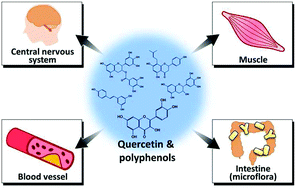Quercetin and related polyphenols: new insights and implications for their bioactivity and bioavailability
Abstract
The physiological functions and bioavailability of flavonoids have been widely investigated since their bioactivities were identified about 80 years ago. Quercetin is a typical flavonoid ubiquitously contained in vegetables and fruits with several biological effects demonstrated in vitro and in vivo including antioxidative, anti-inflammatory, anticancer, and antidiabetic activities. After the ingestion of vegetables and fruits, quercetin glycosides are metabolized, absorbed, and circulated as types of conjugates in the blood. Thereafter, quercetin-3-O-β-D-glucuronide (Q3GA), a major metabolite of quercetin, is distributed throughout the body where it may exert beneficial functions in target tissues. Hydrophilic Q3GA has been found to be deconjugated into hydrophobic quercetin aglycone at injured sites which, in turn, may improve the pathological conditions. This review presents updated information on the biological aspects and mechanisms of action of quercetin and its related polyphenols. In particular, new insights into their beneficial health effects on the brain, blood vessels, muscle, and intestine will be discussed.


 Please wait while we load your content...
Please wait while we load your content...